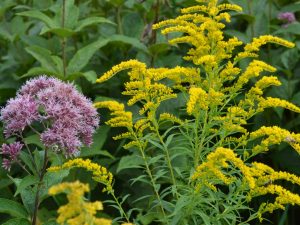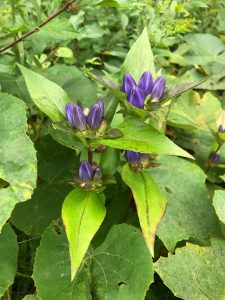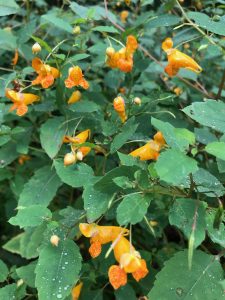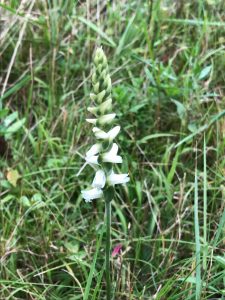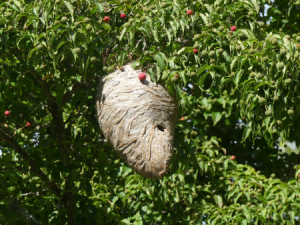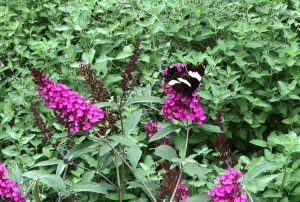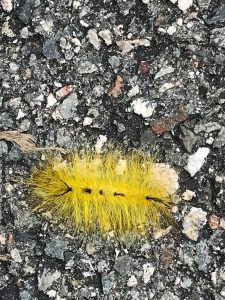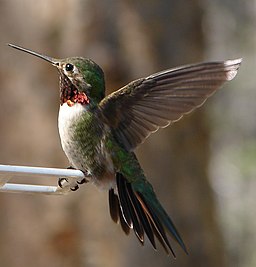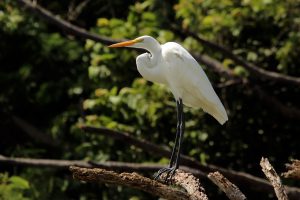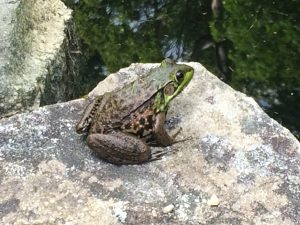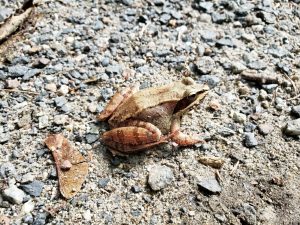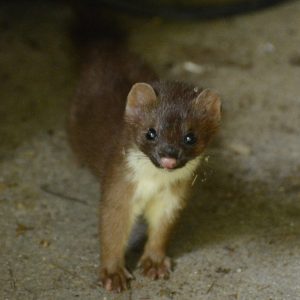Written by Gwyn Loud for the Lincoln Land Conservation Trust. She welcomes your sightings, photos, and questions at 781-259-8690 or at gwynloud555 (at) gmail.com.
Cool nights and diminishing hours of daylight tell us that fall is coming; it will arrive officially on September 23, the autumnal equinox in the northern hemisphere. Seeds and berries abound on numerous trees, shrubs, vines, and flowering plants. This promises to be a huge mast year, with plenty of acorns and cones for wildlife to eat and stash away for future meals. A Laurel Drive resident counted forty-six acorns just on one three-foot branch! Blue jays and squirrels eat acorns from high in the tree whereas chipmunks, wild turkeys, deer and foxes will eat ones fallen to the ground. It is estimated that blue jays eat 3000-5000 nuts in a season. They can carry as many as five acorns at once and fly as far as a mile and a half from the oak tree in order to bury them. Of course finding them later is important; luckily the hippocampus area of their brain, which deals with memory, is large. Not all the buried acorns are eaten, meaning that some sprout to grow new oak trees.
The white pines are producing cones in abundance for the first time in a few years, so in the woods we can expect to see middens, piles of pine cone scales left by red squirrels after they have eaten the seeds. Berries on many shrubs as well as on vines such as Virginia creeper, poison ivy, and wild grape provide food for birds and flowering plants are still attracting bees, butterflies and hummingbirds. When cleaning up your garden it is good to leave some seed-heads for a while to let the birds enjoy their natural food.
Goldenrod is flowering profusely, bringing bands of yellow to roadsides and fields. It is often blamed for hay fever, when the inconspicuous ragweed is usually the culprit. Other flowers in bloom now are both white and lavender asters, smartweed, with its nodding pink blossoms and, in damp spots, jewel-weed and turtlehead. In fields look for Queen Anne’s lace, black-eyed Susan, Joe-Pye-weed, and red clover and in the woods you may come across the red berries of Jack-in-the-pulpit and the low-lying partridgeberry. A good place to find the lovely blue closed gentian and ladies’ tresses (a small orchid) is along the path going west through the meadow and by the orchard beyond the St. Anne’s parking lot.
Among invasives, Japanese knotweed is displaying its white flowers at this season. It is extremely hard to eradicate. Black Swallowwort is also hard to remove but right now, when its seed pods are still green, it is possible to tackle it by removing the pods before they burst with thousands of wind-borne seeds.
Late summer and early fall are seasons when insects flourish and on mild days and evenings we enjoy the chorus of crickets, grasshoppers, katydids, and cicadas. Honeybees as well as many species of wild bees can be seen on flowers, all doing important jobs as pollinators. Wasps are very evident now too, as their numbers have grown during the summer in their nests. Yellow-jackets are wasps which you may find hovering around your picnic. If you see them going in and out of a hole in the lawn, beware, as that is the entrance to their underground nest and they sting! A more visible nest is that of the bald-faced hornet (a type of wasp) which looks like a gray papery globe hanging from a tree branch. Wasps die off in the winter with only the fertilized queens surviving, hibernating in sheltered spots.
Among the butterflies observed over recent weeks, monarchs have been seen often, a welcome fact as a couple of years ago their numbers were alarmingly low. The ones we see now are migrating and feeding on nectar to build up their lipids. They will barely eat during their five-month wintering stay in in the mountains of Mexico. To learn more and follow the monarch migration go to www.journeynorth.org. Other butterflies reported have been fritillaries, a white admiral and three species of swallowtails: Eastern tiger, black, and giant. We don’t usually pay much attention to moths, but during the Walden BioBlitz back in July an astonishing number of species of moths, over two hundred, were recorded by naturalists at Drumlin Farm using UV lights and white sheets at night. You may have seen the larval form of a moth on your tomato plants in the form of a tobacco hornworm. These large green caterpillars, devouring the leaves, are larvae of a sphinx moth. They often have little white spikes on them which are the cocoons of a brachonid wasp which has laid eggs inside the caterpillar. The eggs hatch and then the wasp larvae eat the living caterpillar from the inside, slowly killing it, and spin whitish cocoons on the surface of the hornworm.
So far I have seen two of the familiar woolly bear caterpillars; they will emerge next spring as Isabella tiger moths. And a few days ago I found a handsome caterpillar, bright yellow and very hairy, the larva of the cottonwood dagger moth.
Dragonflies and damselflies have been numerous in recent weeks and perhaps you witnessed the hatching of flying ants at the end of August. They emerge from the ground like a swirling cloud for just one or two hours in a nuptial flight and then they are gone! I should also mention mosquitoes and the fact that Equine Encephalitis has been found in MA. Please take the precautions recommended by the Town.
Birds are starting to move south, some quietly and others in noisier flocks such as grackles and blackbirds. Our ruby-throated hummingbirds usually leave by mid-September. Observers have seen lingering summer residents such as scarlet tanagers, Baltimore orioles, rose-breasted grosbeaks, house wrens and Eastern wood-pewees. At Drumlin Farm a surprising number (27) of immature wood ducks were on a small pond and thirty-one bobolinks were feeding in a field. Indigo buntings have nested in several locations this summer. Migrating fall warblers have not been seen so far in any numbers. An exciting sighting, perhaps the first for Lincoln, was of two great egrets by the Heywood’s Meadow pond. Other avian reports of note include a bald eagle seen on the Cambridge Reservoir from Trapelo Road, a solitary sandpiper and American kestrel at Drumlin Farm, several common ravens (becoming more common!) and, sadly, a dead young pileated woodpecker on the road. Wild turkeys are roaming around town, with the poults now teenagers. American goldfinches, the males still in their bright yellow and black breeding plumage, have been seen a lot. Soon they will molt to their drabber winter colors.
Deer have been reported from many places and Matt Celona the crops farmer at Drumlin, wrote, “Based on the number of hoof prints, there are more deer in the field than at any time since I started here in 2005.” A doe with three young fawns has been in the Conant Rd. area recently; one day, rounding a curve, I came across one of the fawns nursing from its mother right in the middle of the road. Coyotes have been howling at night, woodchucks have been invading vegetable gardens, and a winter St. resident wrote, “Raccoons were up on the trellis the last couple of nights grazing on the grapes, dropping them all over the deck for me to clean up in the morning, ignoring me when I turn on the lights and yell at them.” A beaver was seen near the Pierce House gardens and a resident near Farrar Pond photographed a short-tailed weasel.
Frogs are still calling sporadically; one hears single calls from spring peepers and gray tree frogs. Green frogs of all ages can be seen in numbers at the pool in the Italian garden next to the Codman House. Small wood frogs and toads leap out of tall grass in lawns with the approach of a mower. I helped a baby snapping turtle safely across the road, no doubt newly hatched.
Please check the LLCT website www/lincolnconservation.org for upcoming programs and events. “Bird Feeding 101” on Sept. 24 should be of special interest to those preparing to hang feeders for our wintering birds.
© Gwyn Loud


